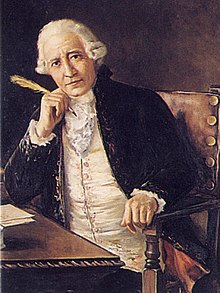Francisco Salva Campillo
This article needs additional citations for verification. (February 2018) |
Francisco Salva Campillo | |
|---|---|
| Francesc Salvà i Campillo | |
 Francisco Salva Campillo (1900) by José María Marqués y García; tribute paid to him by the Royal Academy of Medicine of Catalonia | |
| Born | July 12, 1751 Barcelona, Catalonia, Spain |
| Died | February 13, 1828 (aged 76) |
| Other names | Francisco Salvá |
| Alma mater | University of Valencia, University of Huesca, Spain, University of Toulouse |
| Parents |
|
Francisco Salva Campillo (
Early life and education
Francisco Salva Campillo was born in
He studied at the University of Valencia, where he completed his course in three years instead of the usual four. In 1771, he successfully passed the B.Phil. degree in medicine from the University of Huesca, Spain.[1] He later earned his doctorate in medicine at the University of Toulouse.[1]
Medical career
He started a medical school in Barcelona in an effort to train more doctors and took a special interest in vaccination, particularly against the disease of smallpox. He received several awards from the Paris Society of Medicine.[citation needed]
In 1773, he became, along with Vincent Mitjavila, one of the founding teachers of the Academy of Medical Practice, which is now part of the University of Barcelona (Universitat de Barcelona), Faculty of Medicine.[2] This school was founded in an attempt to unite the two disciplines of clinical and non-clinical studies into a ‘united faculty'.[2]
Telegraphy
In 1795, Dr. Salva presented at the Royal Academy of Sciences and Arts of Barcelona (Spanish: Real Academia de Ciencias y Artes de Barcelona) his first report devoted to "Electricity Applied to Telegraphy."[3][4] Salva demonstrated the basis of electric telegraphy, anticipating the wireless telegraph and undersea cables.[3]
The presentation of Salva attracted the attention of government and he received a formal invitation to demonstrate his telegraphic skills before the Royal Family in Aranjuez.[4]
Legacy
Salva died on February 13, 1828. He left behind a massive library composed of more than five hundred thousand volumes on medical topics. Along with these works, he bequeathed to the Royal Academy of Medicine of Barcelona a sum of four thousand pounds and in accordance with his will, his heart is preserved in an urn, with his books at the same location.[citation needed]
Artist Paul DeMarinis was inspired by Salva for his work The Messenger (1998–2006), which examines the myths of electricity in communication.[5]
References
- ^ ISSN 0018-9219.
- ^ a b "Universitat de Barcelona - Faculty of Medicine". www.ub.edu. Retrieved 2018-02-07.
- ^ S2CID 41550850.
On 16th December 1795 Salvá presented the paper "Electricity applied to telegraphy".
- ^ a b "Salva y Campillo, Francisco (1751 - 1828)". Digital Mechanism and Gear Library (DMG-LIB). Retrieved 2018-10-24.
In 1795 appeared before the Royal Academy of Sciences and Arts of Barcelona with his first report dedicated to "Electricity applied to telegraphy"., Salva's presentation drew the Spanish government attention, which sent a formal invitation for a demonstration before the Royal Family in Aranjuez.
- ISBN 978-1118475188.
